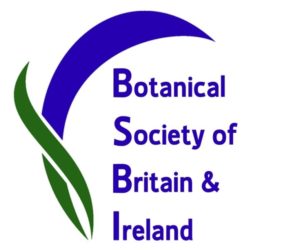Kirkcudbrightshire Botany Group, Black Loch, Colvend, 27th May 2022
What a wonderful site! Not only for the plants and insects, but for the fact that it’s a deep kettle hole [1] and its surrounding ring of floating vegetation, called schwingmoor, which can sometimes, as here, support a person’s weight – with care!
The owner led the way directly to the loch – unusually for us, we ignored the plants on the walk to it – we normally record right from the moment we leave the cars and often get about 300m away in the first hour. And I’m glad we did, for the site supported a large number of plants we don’t usually encounter. Surrounding the loch and schwingmoor there was a wide band of acid marsh/mire, dominated by Purple Moor-grass Molinia caerulea and a variety of mosses including Flat-topped Bog-moss Sphagnum fallax and Blunt-leaved Bog-moss Sphagnum palustre. Within this we recorded Heather Calluna vulgaris, Cross-leaved Heath Erica tetralix, Tormentil Potentilla erecta, Narrow Buckler Fern Dryopteris carthusiana, Wild Angelica Angelica sylvestris, Common Sedge Carex nigra and a couple of rushes amongst other species of this habitat. Both Common Cotton-grass Eriophorum angustifolium and Hare’s-tail Cotton-grass Eriophorum vaginatum were scattered throughout this area. A few plants of Whorled Caraway Carum verticillatum were seen here, in flower.
Nearer the loch, the vegetation become wetter, more acidic and very interesting. The undoubted highlight of the day was to find numerous shoots of Bog Sedge Carex limosa scattered widely throughout this area.
Other sedges here included Slender Sedge Carex lasiocarpa, Common Yellow Sedge Carex demissa, White Sedge Carex curta, Long-stalked Yellow Sedge Carex lepidocarpa, Lesser Tussock Sedge Carex diandra which baffled us for some considerable time, Carnation Sedge Carex panicea, There was a single plant of Round-leaved Sundew Drosera rotundifolia, scattered shoots of Bog Asphodel Narthecium ossifragum, Marsh Arrow-grass Triglochin palustris, Marsh violet Viola palustris, plentiful Marsh Pennywort Hydrocotyle vulgaris, with large areas of Bog Bean Menyanthes trifoliata.
The loch itself was surrounded by more bog bean and right on the edge of the schwingmoor, widespread marsh St John’s Wort Hypericum elodes amongst shoots of Bottle Sedge Carex rostrata, Bladder Sedge Carex vesicaria and Water Horsetail Equisetum fluviatile. The surface of the shallow water of the kettle hole supported Yellow Water Lily Nuphar lutea with a small scattering of White Water Lily Nymphaea alba while grapnel sampling gave us Bog Pondweed Potamogeton polygonifolius and the scarce (for VC73) Horned Pondweed Zannichellia palustris, with Duckweed Lemna minor clinging to the samples.
We lunched in the adjoining unimproved grassland which was awash with flowering Yellow Rattle Rhinanthus sylvatica and Pignut Conopodium majus before returning to the loch area for a final look.
Bob recorded about 75 invertebrate species, including three nationally scarce spiders (a wolf spider Pirata piscatorius, and two money spiders Sintula cornigera and Hypselistes jacksoni), two uncommon dragonflies (the Hairy Dragonfly Brachytron pratense and the Variable Damselfly Coenagrion pulchellum, an uncommon water bug (the tiny Sphagnum Bug Hebrus ruficeps), and two nationally scarce water beetles (including the tiny Chaetarthria simillima). Also present were the photogenic Black-bellied Diving Beetle Dytiscus semisulcatus, water scorpion Nepidae sp. and Water Spider Argyroneta aquatica. The last species is unique in its ability to venture underwater with the aid of a bubble of air trapped by abdominal hairs. He also recorded a Palmate Newt Lissotriton helveticus, while Max got a Horse Leech Haemopis sanguisuga and a Four-spotted Darter Libellula quadrimaculata dragonfly. We also found a single Chimney Sweeper Odezia atrata moth.
I could go on, but this is already long enough. The numerous photos sent in, for which many thanks. I just couldn’t use all just a few, otherwise the report would have been a very large file and a very lengthy screed. So, apologies if your photos weren’t included but I’ve got them on file.
David Hawker
BSBI county recorder for Kirkcudbrightshire VC73
[1] depression/hole in an outwash plain formed by retreating glaciers or draining floodwaters. The kettles are formed as a result of blocks of dead ice left behind by retreating glaciers, which become surrounded by sediment deposited by meltwater streams” – Wikipedia

